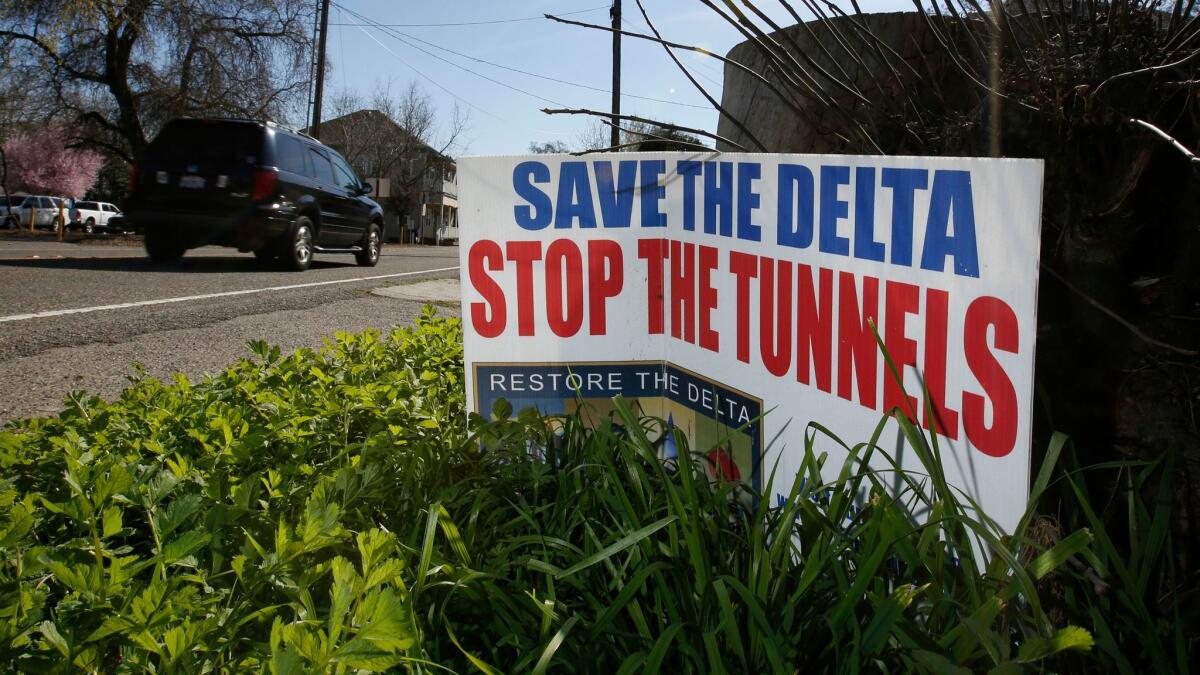Editorial: Many questions linger in water tunnel project

- Share via
After many alternatives, iterations and tweaks, final environmental documents are to be made public Wednesday for a water re-routing project that has come to be known as the California WaterFix. Planners envision two giant tunnels that would divert 9,000 cubic feet of water per second — about as much as a small river — from the northern part of the state, around the environmentally fragile delta and into two intertwined water projects: the federal aqueducts that supply some San Joaquin Valley fields and the California Aqueduct, which carries water south to other parts of the valley and to Southern California urban areas, including Los Angeles.
Even the reports are huge. In paper form, the 90,000 pages would form a stack about 30 feet high.
Don’t expect the documents to mollify critics or to answer every question about environmental and financial costs, however — or to lessen the tension among the many interests that have a stake in the West’s shrinking supply of water. The tunnels, if they are actually built, could provide some security, flexibility and options to California’s complex waterworks, but they can’t end the drought.
Talks are ongoing over the Colorado River, where drought and increasing demand from Arizona and Nevada may reduce California’s share.
A modification of the longstanding State Water Project, the WaterFix will be financed through higher water bills for Southern California ratepayers — an estimated $5 more per household per month, according to a Metropolitan Water District estimate — and agencies that supply San Joaquin Valley growers. Residential costs could be higher if those agricultural suppliers don’t opt in. Many environmentalists and water policy experts argue that the money would be better spent on local projects to capture and reuse storm water, to recycle sewage, and to better monitor use to encourage conservation.
The tunnels won’t tap into any new sources. For decades, the State Water Project has directed water from the Northern Sierra’s Feather River into a regulated flow down the Sacramento River and through the environmentally stressed Sacramento-San Joaquin River Delta. At the delta’s southern end, the water is pumped to aqueducts that supply much of the Bay Area and the southern part of the state. The tunnels would give water managers the option of diverting flow around, instead of through, the delta.
The point is to provide an alternative to the southern delta pumps, which are so powerful that they reverse the flow of the lower San Joaquin River and undermine the migration patterns of salmon and other endangered species. The tunnels also could keep freshwater coming south in the event that the delta’s water supplies become tainted — for example, if an earthquake destroys the levees that keep brackish bay water away from the pumps, or if the rising sea level caused by global climate change inundates the delta with saltwater.
In wet times, the tunnels could refill depleted reservoirs, which could then replenish groundwater. The tunnels’ “big gulp” from the Sacramento River would be reduced to a “little sip” during drought, with available water being reserved to protect endangered fish while farms and families live off the previous stored supply.
For the migrating fish and for a usable water supply for farms and households, then, the project looks like a good idea.
But opponents argue that once the tunnels are built, there will be too little to stop them from being in constant “big gulp” mode and possibly sucking the Sacramento River dry. The fact that such an assault is not possible under the current legal and regulatory framework provides little comfort to environmentalists and delta residents who can recite a California water history replete with deception and extra-legal dealings.
Some environmentalists have sought to prevent any chance of such large-scale water transfers by proposing a single, smaller tunnel, and making up the difference with investments in recycling and conservation.
But such investments, as important as they are to Southern California’s future water portfolio, are unlikely to yield enough to make up for diminishing water due to drought and competing demands. They also would undermine the whole point of the bypass: to reduce the environmental damage inflicted by the current system.
State water officials insist that the project would be financially viable even if a number of potential customers opt out — which they could do, if they conclude that the GOP-controlled Congress and White House will be more friendly to agribusiness than the environment. But it’s impossible to fully evaluate the project’s business model based on the limited information the state has divulged.
The uncertainty puts the Metropolitan Water District, and the 25-million people it serves, in a bind. Talks are ongoing over the Colorado River, where drought and increasing demand from Arizona and Nevada may reduce California’s share. If the tunnels are never built, the Met will need to drive a harder bargain on the Colorado to ensure a reliable supply. And Californians will need to find another way to protect the delta while quenching their thirst.
Follow the Opinion section on Twitter @latimesopinion and Facebook
More to Read
A cure for the common opinion
Get thought-provoking perspectives with our weekly newsletter.
You may occasionally receive promotional content from the Los Angeles Times.






